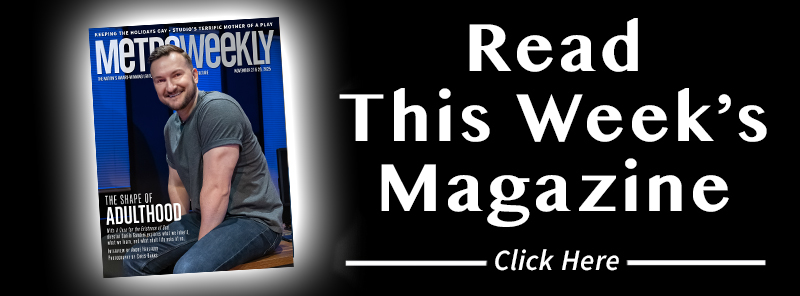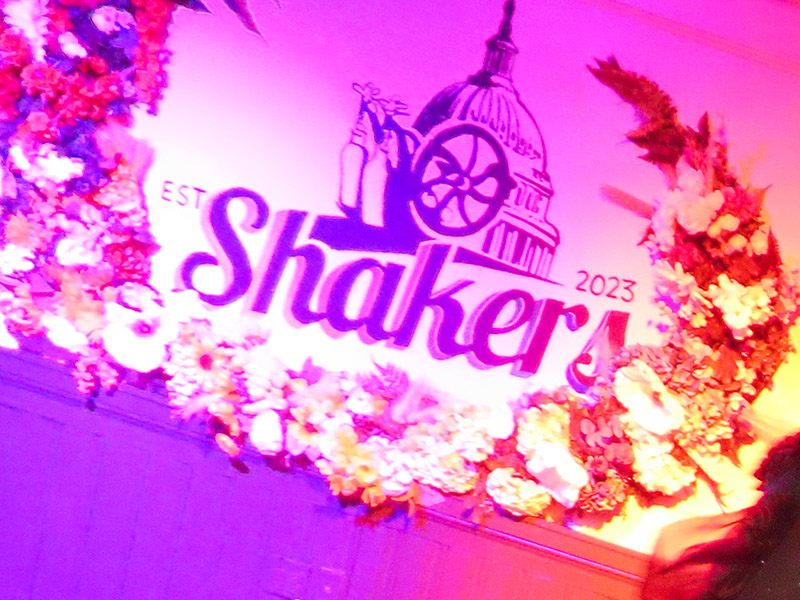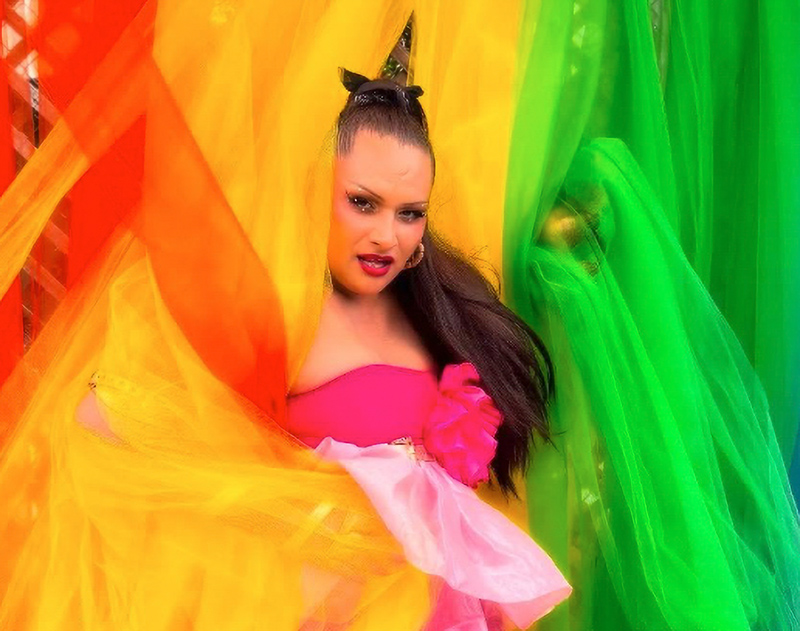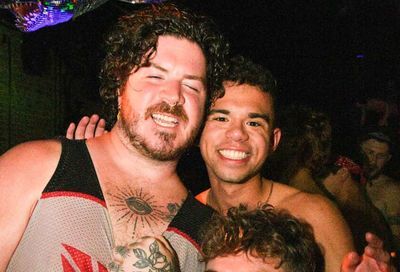Miss Adams Morgan, D.C.’s Biggest Drag Show, Turns 37
The founders of the legendary Miss Adams Morgan Pageant talk about how D.C.'s largest drag event has evolved over 37 years.

“The whole Miss Adams Morgan Pageant really started by accident,” says Steven Brandt, a board member of the Dupont Social Club, which organizes the annual drag pageant, now a fixture on many D.C. residents’ calendars.
Brandt recalls that he and his now-husband, Rick Boylan, were celebrating Halloween in drag with friends when, on their way to a piano bar, walking through Dupont Circle, they were accosted by a group of teenagers.
“It was raining,” recalls Brandt. “They ripped my wig off and threw it in a puddle, spewing all kinds of hatefulness. After that, we decided we needed a place to be able to go in drag if we wanted. It was maybe only the first or second time we’d been in drag, but I was so enraged by the experience that I kept saying over and over, ‘We’ve got to…This isn’t right.'”
The next year, in 1988, the two invited friends to join them in drag at Annie’s Paramount Steak House — then located where JR.’s Bar is — and held a mini-pageant at the restaurant.
“The very first pageant, there were 16 of us, located at one table, and we just decided that we were all going to dress in drag and have a pageant, just for fun, and name the winner the Queen of Miss Adams Morgan, because that’s where we all lived,” says Boylan. “We unofficially called ourselves the Dupont Social Club, as just kind of a friend thing.”

“At the first pageant, the only thing we did was vote for who was the prettiest or who had the most personality. And I won,” adds Brandt, known in drag as Miss Adams Morgan 1989 Dianna Spencer.
In 1989, the pageant was held at a private residence. In later years, it moved to the third floor of La Fonda restaurant at 1639 R St. NW, then to the Kennedy-Warren Apartment Building ballroom as crowds grew. Word of mouth fueled its reputation, leading to a stint at the Capitol Hilton before settling, in 1996, at the Washington Hilton’s International Ballroom.
At the height of its popularity, the pageant drew 2,400 attendees. After a one-year COVID hiatus in 2020, attendance dipped but has rebounded to about 1,600. It remains the District’s largest drag pageant.

A talent segment was added in the second year.
“We patterned ourselves after the Miss America pageant,” says Brandt. “We even have a Miss Congeniality. It’s pretty much exactly like the Miss America pageant, only in drag.”
Subsequent years saw the addition of the “Parade of States,” where contestants chose a state to represent and create a costume — and sometimes a performance — reflecting that state’s identity.
“Most people choose the state that they were living in or born or grew up in, but it’s not necessary,” says Brandt. “States like Nevada were really popular 20 years ago because you could do a lot with Vegas. We had one person come out in the Parade of States in a full-sized skirt that was actually a roulette wheel, complete with the ball.”
“And at some other point [that same contestant] represented Alaska, she came out in an igloo,” chimes in Boylan, who was crowned Miss Adams Morgan as Miss Melody Lane in 1990. He notes that contestants are not necessarily tied to specific states — or even to names, some of which have been changed “five or six times.”
Brandt notes that some performers keep their pageant names to build a following of fans, friends, and allies who return each year.
“Once we hit year five, the contestants really started to develop a personality of their own,” he says. “And when we would go out in D.C. in the ’90s and early 2000s, people would stop and say, ‘Aren’t you Miss Adams Morgan?’ So it became more important to keep your name or your state so people could follow you and identify you at the next pageant.”
Reflecting on the pageant’s evolution, Brandt notes that earlier competitors often chose drag names mirroring real people, while today’s names are more likely rooted in puns or tied to “drag family” traditions.

Now in its 37th year, the pageant typically features around six contestants, who are recruited through the Dupont Social Club’s monthly happy hours, held at various bars across the city on the last Friday of each month.
As members get more involved in the club’s events and talk with past contestants, their interest in performing often grows. Many start out as “hostesses” on pageant night, assisting with crowd control, stage setup, or other behind-the-scenes duties. Hostesses also typically perform together in a group number between contestants.
When newer members become contestants, they usually start planning months ahead — organizing state-themed outfits for the Parade of States and working out the tricks, props, and routines for their talent performances. “In the early days, we used to jokingly say that we did this pageant once a year, but we talked about it 364 days a year,” says Boylan. “That’s still true.”
Another change over the years, Brandt adds, is the growing complexity of the on-stage numbers.
“Back in the day, all we needed was a good ballad or a good love song or something, and we would perform on stage, without props. We used to do one song per person, and I recorded it on a cassette tape. But as it got more and more competitive each year, and these personalities began to emerge, the acts became more involved. Now, if you have less than three songs in your routine, you might as well hang it up.”

This year’s pageant, set for Saturday, October 4, begins with two hours of cocktails at 6 p.m., followed by a show that typically runs until midnight. Performers and Dupont Social Club board members often start getting in drag as early as 1 p.m., many opting to stay at the hotel to avoid hauling makeup, clothing, props, and other materials.
Attendees are also encouraged to dress in costume. This year’s theme is “Studio 54 Forever: Beyond the Velvet Rope,” with ticket-holders urged to dress “like you’re going to be flashy enough to get inside Studio 54,” says Boylan, who will emcee part of the event. Others often choose their own off-theme attire, ranging from tuxedos to thongs.
“It’s whatever you want to wear to just be fabulous,” says Boylan.
“It’s a little different now, too, because there’s not just the event,” adds Brandt. “What happens on Saturday night is people who know the pageant is at the Hilton will show up, and we’ll sit in the lobby with folks from off the street who are amazed by it. We’ll have drinks together, and some buy tickets for the show, but others just come for the lobby action, when we’re running around the hotel in full drag. It becomes a party in itself, even before the actual show.”
Adding to this year’s excitement, board members announced that Utica, of RuPaul’s Drag Race and Project Runway, will attend. In past years, mini-celebrities and notable dignitaries have also joined or participated in the pageant.
As the first Miss Adams Morgan, Brandt has made it a tradition to crown the winner each year. One year, he had help from a surprise guest: Miss America 1998 Kate Shindle, an actress, singer, AIDS activist, and former president of the Actors’ Equity Association.
“I was out getting ready to do my thing, and they announced that there was a guest who wanted to walk the runway with me,” he recalls. “And out she came in her Miss America crown, and I’ll never forget, she took it off her head and put it on my head, and the two of us walked that runway. It still gives me cold chills to this day. It was such a fantastic moment.”

Another year, a contestant known as Miss D.C. Frangelica Houston, who worked at the White House, invited former intern Monica Lewinsky to the pageant, sparking rumors she was in the crowd. Lewinsky wasn’t, but Bill Clinton’s personal secretary, Betty Currie, did attend as one of Houston’s guests.
Over its 37-year run, the pageant has raised $362,500 for local nonprofits. The Dupont Social Club’s annual Valentine’s Day drag benefit has added $122,700, bringing total charitable giving to more than $485,000 — on pace to top half a million after this year’s event.
“We never started out as a charitable organization. We were just happy that the event paid for itself in the early days,” says Boylan.
“We whipped out our credit cards and four of us would pay for everything,” adds Brandt, noting there was no admission charge until the pageant’s fourth year. “Whipping out that credit card at La Fonda on year three was a little hard to swallow, because we had about 60 people and an open bar.”
Eventually, organizers began charging $5 a head to cover costs, though they never envisioned giving proceeds to charity.
“We didn’t really have an operating budget,” says Brandt. “The first time we had $80 left over, we gave it to the bartender. But the following year we started donating to charities. Once we regularly had proceeds left, we decided the reigning queen would choose the recipient — required to be a local LGBTQ or HIV/AIDS organization, like SMYAL or Food & Friends.”
Notably, this is the first year the Miss Adams Morgan Pageant has actively sought publicity. In the past, details outside the club’s circles were scarce, and many contestants stayed tight-lipped about participating — largely due to the lack of societal acceptance of gay people, and drag performers in particular.
“It was so bad when we first started this back in the 1980s,” says Brandt. “You had to be really careful going into a bar, because people would literally sit outside with cameras and take pictures of license plates, and then of people, and it would end up in the local newspaper, basically outing them. So many people worked on the Hill, and it was difficult to be openly gay in the ’80s and ’90s. That didn’t change much until the early 2000s, when drag became a staple of the city.
“And with the introduction of RuPaul’s Drag Race, it’s just completely different today,” he continues. “I don’t believe there’s anybody who’s going to be on the stage who might be concerned about their identities. There may be, but I don’t know of anybody. It’s just so different.”

Brandt says the pageant’s legacy lies in the safe space it has provided for drag performers and the sense of togetherness it has fostered among past and future competitors.
“The one thing that I don’t want to get lost is, over the last 37 years, this has really become our family,” says Brandt. “One of the most beneficial aspects of being part of this organization is the friendships we’ve gained and the sense of community from this family that we choose. Practically everyone we know is part of the show or the audience.”
“I think people who attend the pageant will leave with an understanding that we are there celebrating our community, having a good time, and celebrating each other,” adds Boylan. “It’s a reason why we’ve become the largest drag show in D.C., because people can see the camaraderie that we have and the fun that we’re having doing this annual event.”
The 37th annual Miss Adams Morgan Pageant is Saturday, Oct. 4, from 6 p.m. to midnight at the Washington Hilton, 1919 Connecticut Ave. NW, in Washington, D.C. Tickets are $100 per person and available at www.mamp.ticketspice.com/mamp37.
To learn more about the Dupont Social Club, visit www.thedupontsocialclub.com.
Click here to see dozens of more photos from Miss Adams Morgan 1988-2024 in this week’s magazine.
Don’t drag your feet. Subscribe now for free to Metro Weekly magazine and never miss an LGBTQ beat!
Support Metro Weekly’s Journalism
These are challenging times for news organizations. And yet it’s crucial we stay active and provide vital resources and information to both our local readers and the world. So won’t you please take a moment and consider supporting Metro Weekly with a membership? For as little as $5 a month, you can help ensure Metro Weekly magazine and MetroWeekly.com remain free, viable resources as we provide the best, most diverse, culturally-resonant LGBTQ coverage in both the D.C. region and around the world. Memberships come with exclusive perks and discounts, your own personal digital delivery of each week’s magazine (and an archive), access to our Member's Lounge when it launches this fall, and exclusive members-only items like Metro Weekly Membership Mugs and Tote Bags! Check out all our membership levels here and please join us today!






























You must be logged in to post a comment.